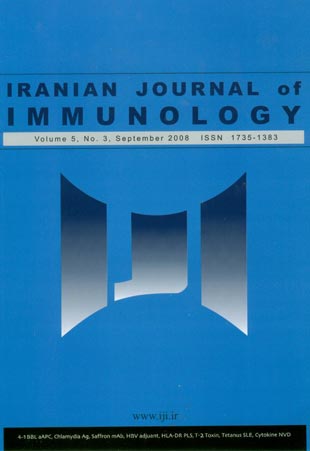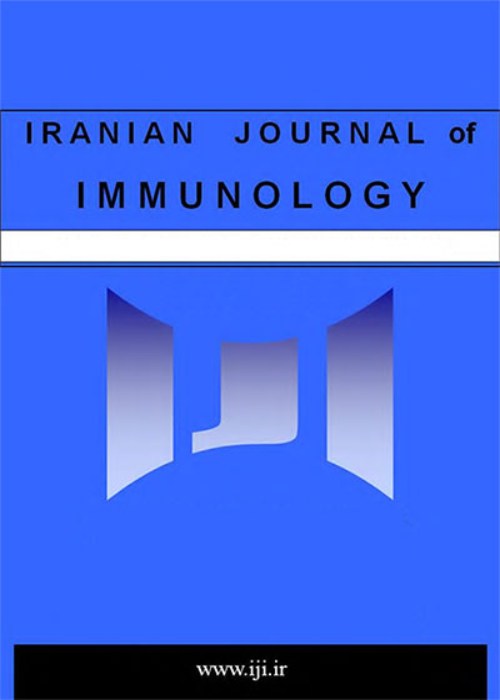فهرست مطالب

Iranian journal of immunology
Volume:5 Issue: 3, Summer 2008
- 56 صفحه،
- تاریخ انتشار: 1387/07/05
- تعداد عناوین: 8
-
-
Pages 136-147BackgroundVarieties of artificial antigen presenting cells (aAPCs) with different efficiencies have been introduced to expand whole T cell population or antigen specific ones for the purpose of T cell therapy. From antibody coated beads to gene modified dendritic cells each has some advantages and disadvantages. However, no one can ignore the importance and the necessity of costimulation interaction during T cell activation.ObjectiveThis study was designed to compare the effectiveness of CD80/CD86 and 4-1BBL, two major costimulatory families, in costimulation of autologous T cell responses.MethodsWe used recombinant non-replicative adenoviral vectors and transferred genes of these ligands to autologous blood monocytes and skin fibroblasts to create aAPCs system. T cell response to anti-CD3 pan stimulation and some viral peptide Ags, in co-culture with gene modified monocytes and fibroblasts were studied using CFSE and HLA tetramers, respectively.ResultsOver-expression of ligands was able to expand the T cell population significantly higher than normal cells with no interference with antigen stimulation. Presence of 4-1BBL alone or in combination with B7 members enhanced T cell expansion and promoted more Ag-specific cells to accumulate in these culture systems.ConclusionConsidering the inhibitory proportion of B7 costimulation route, 4-1BBL, as an alternative signaling pathway, in combination with B7 will promote T cell proliferation and expansion.
-
Pages 148-155BackgroundAlthough a simple and direct method does not exist for the detection of chlamydial infections, there are situations in which reliable serological tests, with sensitivity related to a specific antigen, could be helpful.ObjectiveThe aim of this study was to clone the first 1100 bp of the C. trachomatis outer membrane protein 2 (omp2) gene in order to prepare a recombinant protein for use in an ELISA system designed to recognize the anti- C. trachomatis antibody in patient sera.MethodsThe PCR product of the chlamydial omp2 gene was cloned in pBluescript and its first 1100 bp was subcloned in the pQE-30 expression vector and induced by IPTG. The recombinant protein was purified by affinity chromatography and its purity was confirmed by SDS-PAGE, gel diffusion and western blot analyses. The purified protein was coated onto a polystyrene microplate and tested by ELISA using patient serum.ResultsWe have cloned, over-expressed and purified biologically functional recombinant truncated Omp2 from C. trachomatis for use, as a species-specific recognition antigen, in an ELISA system. In this study we determined a cut-off value of 0.345 for this ELISA system using 55 negative sera and measured six positive sera at dilutions of 1:20-1:2560.ConclusionAs a species-specific recognition antigen, the over-expressed and purified recombinant truncated Omp2 from C. trachomatis performed well in an ELISA system.
-
Pages 156-162BackgroundAllergy to Saffron (Crocus sativus) pollen has been described in people involved in processing of saffron flower stamens. Profilins have been identified as a pan-allergen in different plant pollens and foods. This molecule is an actin-binding protein with a molecular weight of 12-16 kDa found in eukaryotic species.ObjectiveThe aim of this study was to generate monoclonal antibody against Cro s 2 in order to characterize this major allergen of saffron pollen.MethodsBALB/c mice were immunized to obtain adequate humoral response. Splenocytes were prepared from the immunized animals, mixed with the P3-X63-Ag8.653 myeloma cells and fused by means of PEG 1500. After two weeks of culturing in HAT-containing media, the supernatant from those wells growing hybridomas were screened by ELISA using plates coated with Cro s 2. Cells from positive wells were cloned at least 3 times by limiting dilution. Specificity and cross-reactivity of the mAbs were determined by Western blot analysis and sandwich ELISA.ResultsTwo stable hybridoma clones secreting mAbs against Cro s 2 were obtained and expanded. The anti-Cro s 2 mAbs were also found to cross-react with other plant profilins. Isotype of this mAb was identified as μ heavy chain and k light chain.ConclusionThe anti-Cro s 2 mAb could be a useful tool for characterization and standardization of many pollen and fruit-derived profilins.
-
Pages 163-170BackgroundSeveral adjuvants have been evaluated for vaccine formulations but aluminum salts will continue to be used for many years due to their safety, low cost and adjuvanticity with different antigens. Two commonly used aluminum adjuvants, aluminum hydroxide and aluminum phosphate have different adjuvanticity properties. Commercial recombinant protein hepatitis B vaccines containing aluminum hydroxide is facing low induction of immunity in some sections of the vaccinated population.ObjectiveIn this study, to follow the current global efforts in finding more potent hepatitis B vaccine formulations, adjuvanticity of aluminum phosphate, aluminum hydroxide and their combinations has been evaluated.MethodsThe formulated vaccines were administered intra-peritoneally (i.p.) to BALB/c mice and the titer of antibody was determined after 28 days using ELISA technique. The geometric mean of antibody titer (GMT, mIU/ml), seroconversion and seroprotection rates, ED50 (ng) and relative potency (μg/dose) of different formulations were determined.ResultsGMT of antibody titer, seroconversion and seroprotection rates showed significantly higher adjuvanticity for aluminum phosphate than other formulations. The ED50 of aluminum phosphate was approximately two fold less than other formulations.ConclusionAluminum phosphate showed more adjuvanticity than aluminum hydroxide and their combinations in hepatitis B protein vaccine. The use of aluminum phosphate as adjuvant leads to higher immunity which may result in more protective response in vaccinated groups.
-
Pages 171-176BackgroundPapillon-Lefevre syndrome (PLS) is a rare autosomal recessive disorder characterized by palmoplantar hyperkeratosis and early development of aggressive periodontitis. Although cathepsin C (CTSC) gene mutations have been established in about 70-80% of PLS patients, it is assumed that the patients may have dysfunctioning of immune defense mechanisms.ObjectiveTo assess the association of HLA class II genes and PLS.MethodsHLA class II genes were typed in nine Iranian PLS patients and their family members and the results were compared to 816 Iranian healthy subjects.ResultsThe results of this study revealed that DRB1*0101 and DRB1*0301 alleles were more frequent in PLS patients than in normal controls. However, there was no significant difference between PLS patients and normal controls. Moreover, the same haplotypes and genotype combinations were also observed in some patients and their healthy siblings.ConclusionThe results of this study showed no strong association between HLA class II alleles and PLS.
-
Pages 177-180BackgroundT-2 toxin is a mycotoxin of type A trichothecenes produced by several fungal genera such as Fusarium species. Mycotoxins can affect both cell mediated and humoral immune compartments.ObjectiveThe purpose of this study was to investigate the effect of T-2 toxin on cytokine production by mouse peritoneal macrophages and lymph node T cells.MethodsMouse peritoneal macrophages and lymph node T cells were isolated and treated with different concentrations of T-2 toxin and incubated at 370C and 5% CO2 in air for 48 hours. Cell free media were removed and used for cytokine assay by an ELISA method.ResultsT-2 toxin significantly reduced IL-1β release in a concentration dependent manner (p<0.005, p<0.001). Interleukin-12 and TNF-α production were significantly increased in response to 0.001ng/ml, 0.01ng/ml and 0.1ng/ml of T-2 toxin (p<0.001). However, T-2 toxin at higher concentrations ranging from 1ng/ml to 100ng/ml, reduced both IL-12 (p<0.001) and TNF-α production (p<0.005, p<0.05). The effects of T-2 toxin on lymph node T cells showed that IL-4 and IL-10 release was decreased in a concentration dependent manner (all with p<0.01). T-2 toxin at concentrations between 1ng/ml and 100ng/ml reduced the release of both IL-2 and IFN-γ (p<0.05, p<0.001).ConclusionThe results suggest that T-2 toxin at low concentrations can highly induce secretion of IL-12, TNF-α, IFN-γ and IL-2 and it may be used as a positive immunomodulator in the human model.
-
Pages 181-184BackgroundInfection is now the most common cause of morbidity in Systemic Lupus Erythematosus (SLE). There is lack of information regarding the specific antibody formation in response to vaccines in young SLE patients.ObjectiveTo determine the efficacy of anti-tetanus antibody response in young patients with SLE.MethodsForty SLE patients with mean age of 14.1 years (range: 7-21) and 60 age and sex matched normal controls were enrolled in this study over a period of one year. Diagnosis was made according to the ACR criteria and disease activity was determined based on SLE Disease Activity Index (SLEDAI). All patients and controls had received the complete schedule of tetanus vaccinations consisting of three primary doses and two boosters by the age of six. Serum immunoglobulins and anti-tetanus antibody titers were determined by Nephelometry and ELISA. Anti-tetanus antibody levels greater than 0.1 IU/ml have been suggested as protective.ResultsIn all of the patients and controls anti-tetanus antibody titer was > 0.1 IU/ml. IgG, IgA, and IgM levels were in the normal range for their age. Mean disease activity score was 4.9 (range: 0-16). There was no association between SLEDAI score and anti-tetanus antibody response.ConclusionSchool age onset and immunosuppressive therapy does not seem to interfere with development of consistent immunity to tetanus vaccine in young SLE patients.
-
Peripheral, Placental and Cord Cytokines Profile in Spontaneous Labor and Elective Caesarean SectionPages 185-188BackgroundCesarean section delivery can lead to much maternal morbidity. Different cytokines have been reported to be influenced by the mode of delivery.ObjectiveTo investigate the influence of mode of delivery on maternal, placental and cord sera of interferon gamma (IFN-γ), interleukin-4 (IL-4) and interleukin-10 (IL-10) levels.MethodsThese three cytokines were measured using ELISA in peripheral, placental and cord sera of two groups of women (38 in each group), either delivering vaginally or by elective cesarean section.ResultsConcentrations of IFN-γ, IL-4 and IL-10 in the peripheral and placental sera were higher in vaginal delivery, while cord cytokines were not significantly different in the two groups. Cord sera contained significantly less concentrations of these cytokines than the peripheral and placental sera.ConclusionIt appears that the levels of IFN-γ, IL-4 and IL-10 are influenced by the mode of delivery.


